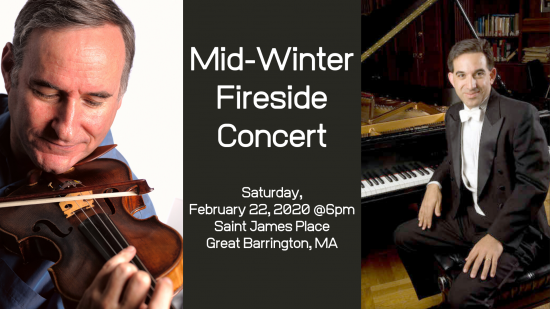Winter in the Berkshires is beautiful. But often there are long stretches with plenty of gray and cold – but not a lot of snow. We all turn inward at these times. That’s why we’re so excited about Close Encounters With Music’s (CEWM) February 22nd performance here at Saint James Place. They call it a Mid-Winter Fireside Concert; we call it a welcome and beautiful distraction from the doldrums of the season. (Jump to cewm.org for performance tickets.)

Grand Piano Trios – Schubert and Brahms – features CEWM artistic director Yehuda Hanani, cello, Max Levinson, piano, and Peter Zazofsky, violin. We’re honored to feature a Q & A here with Peter Zazofsky. Zazofsky has had a significant career as a soloist, chamber musician and educator that spans thirty years, thirty countries and five continents. He often plays with CEWM and is an instructor at their Berkshire High Peaks Festival in the summer (watch for a performance here at Saint James Place).
Zazofsky leads us through the Schubert and Brahms works to be performed on the 22nd: Schubert’s Trio in B flat Major and Brahms’ in B Major. Read on!
Q What makes these works iconic?
A There are so many factors: rhythm, harmony, the feelings they evoke, but I start with the tunes! Audience members will be whistling them long into the night, and forever after.
Think of the very beginning: Schubert starts his long journey with a heroic four-bar march, and an extra measure of joyous virtuosity. This master of the long line then stops, à la Beethoven, and resumes a step higher in minor before leading us so cleverly to the Viennese dance floor.
Brahms begins with the piano, and very soon the cello joins, in a duet for the ages. What wisdom, philosophy and solace we find here. This theme will achieve heroic status in due course, but the second theme will be anxious, even sorrowful, as he works from darkness to light.
Q What do you look for in a chamber music partner?
A An ideal chamber partner has many characteristics. Here are just a few: 1) the ability to play with absolute commitment, while also reacting to the phrasing and inflection of colleagues; 2) the ability to adjust – tempo, bowing, dynamic and nuance – when circumstances dictate it. Even tuning can be affected by weather, a tiny slip of a finger, peg, or pedal. (The joys and perils of live performance!); the curiosity, and idealism, to revisit ideas – large and small, in the spirit of utmost respect and collegiality.
Q How has the classical music world changed since you won the Queen Elisabeth of Belgium Prize, and since you entered the scene?
A This is a huge subject, with many facets. Simplest to say that there’s a great yearning for great music, beautiful and not beautiful. Young musicians fall in love with it, as I did. The excitement of famous competitions, and the recognition of high prizes, led to a long and fulfilling career – a life in music. And now, as senior players, this love burns ever brighter –informed by decades of playing and teaching these masterpieces.
Peter Zazofsky holds the position of Associate Professor of Violin and Chamber Music at Boston University and serves as a jury member for the violin competitions in Montreal, Brussels and Odense, Denmark.
About Close Encounters With Music: Twenty-eight years ago, Close Encounters’ artistic director and cellist Yehuda Hanani began presenting thematic concerts of chamber music with commentary—at the time a novel and innovative format that has since become ubiquitous in the concert hall. In addition to tours that have taken the series to cities such as Chicago, Cincinnati, Milwaukee, Omaha, Calgary, and Kansas City, Scottsdale, Fort Lauderdale and Miami, Close Encounters presents concerts each season in the Berkshires. To date, over 100 themes have been explored in the series’ programs.
(Jump to cewm.org for performance tickets.)